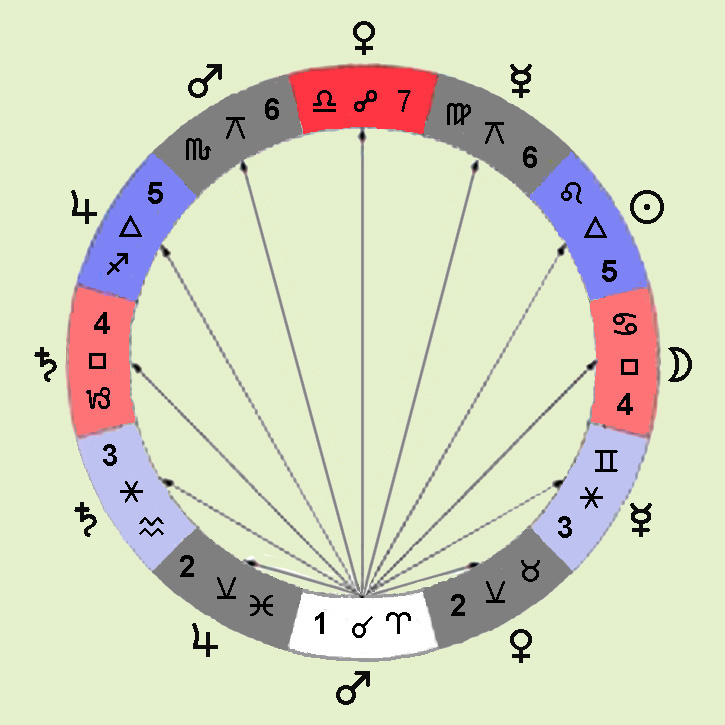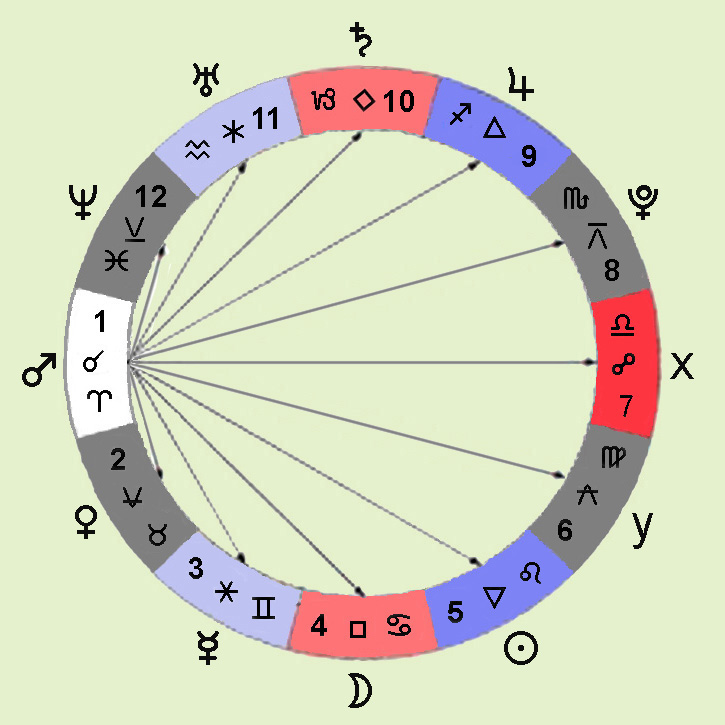|
Traditionally, there are seven astrological aspects in astrology based on a symmetrical view of the twelve zodiac signs as well as their their relationship to the seven visible planets.
Of these seven aspects, two are singular(conjunction and opposition) and five are dual(semi-sextile, sextile, square, trine, and quincunx), so that in reality there are actualy twelve astrological aspects(two semi-sextiles, two sextiles, etc.) The conjunction is of the nature of Aries and signifies similarity or emphasis whereas the opposition is of the nature of Libra and signifies balance or compromise. The semi-sextile is of the nature of Taurus and Pisces and signifies gain or loss. The sextile is of the nature of Gemini and Aquarius and signifies ideas and associations. The square is of the nature of Cancer and Capricorn and signifies private or public issues that need to be adressed. The trine is of the nature of Leo and Sagittarius and signifies creativity and opportunity. The quincunx or inconjunct is of the nature of Virgo and Scorpio and signifies stress or intensity. Similarily, in traditional astrology, there are two single-sign ruling planets(Sun and Moon), and five double-sign ruling planets(Mercury, Venus, Mars, Jupiter, and Saturn. The Sun rules Leo and the Moon rules Cancer. Mercury rules Gemini and Virgo, Venus rules Taurus and Libra, Mars rules Aries and Scorpio, Jupiter rules Sagittarius and Pisces, and Saturn rules Capricorn and Aquarius. The diagram below clarifies this.
 This seven-fold scheme worked well for the last 1800 years or more, and still does, but it is highly ambiguous. The discovery(or re-discovery) of planets beyond normal human sight is clarifying or singling out the double rulerships, and the aspects should likewise follow suit. This singularization process is necessary in our ever-growing and increasingly complex society. The old generalizations and associations, while still valid to some extent, will just not suffice or satisfy anymore. With the discovery of Uranus(1781), Neptune(1846), Pluto(1930), and other bodies not yet officially recognized as rulers, there is an unfolding process occurring. From seven major bodies in astrology before 1781 we are now, in the 21st century, heading for at least twelve major ruling bodies. And just as the rulerships are unfolding, so should the aspects be unfolding as well. There should be twelve instead of seven aspects. The conjunction and opposition aspects will obviously remain the same since they are already singular, but the remaining dual or double aspects need to be singularized and their glyphs changed accordingly. The semi-sextile, for example, can signify either gain(Taurus/second house) or loss(Pisces/12th house). It is important to know which, otherwise the interpretation becomes skewed. This is one of the great failings of modern astrology. We speak of planets being in semi-sextile(primarily by sign) without indicating if it is a 2nd house semi-sextile(also known as dexter or lower) or a 12th house semi-sextile(also known as sinister or upper). The diagram below clarifies this. The aspect glyphs have been uniquely modified, by myself, to signify or correlate to a particular sign, house, or planet.
 The "diamond" or 10th house square glyph is more accurate in describing the hard Saturn/Capricorn nature, whereas the "box" or 4th house square glyph(which can be seen as a house or foundation) better describes the Moon/Cancer nature. The trine glyph can be pointing upwards like a a pyramid(9th house/Jupiter/Sagittarius), or pointing downwards to baser or more personal desires and interests(5th house/Sun/Leo). Then there is the lower or 3rd house sextile glyph commonly used(Mercury/Gemini) to signify the lower mind or daily communication, or the higher mind hopes and goals 11th house sextile glyph(pointing upwards) associated with Uranus/Aquarius. The semi-sextile and quincunx aspects are differentiated by simply moving the V part up or down signifying the lower or higher versions of those aspects. Just as Taurus and Pisces, for exanple, cannot be lumped together into one sign(even though they share some similarities), and just as Venus(true ruler of Taurus) and Neptune(true ruler of Pisces) are very different, so the semi-sextile must present two entirely different meanings. This applies equally to the sextile, square, trine, and inconjunct. This has far reaching implications for all manner of interpretations in astrology, from natal, to synastry, to predictive work, to locational astrology. For Aries, for example, any planet in Leo or Sagittarius will be in trine aspect and therefore highly beneficial, but Leo will have a 5th house meaning or flavour to it, whereas Sagittarius will have a 9th house meaning or flavour. Both are fire signs, but one is fixed and the other is mutable. Also, while Aries sees Leo in a 5th house manner, Leo sees Aries in a 9th house manner. It's a matter of perspective. In whole sign astrology, houses and aspects are the same. The astrological houses, are in fact, a sophisticated way of differentiating the aspects. Since the Ascendant is the Earth, any relationship to it from any other planet is viewed or described in terms of houses. Mars in the fifth house, for example, simply means that Mars is in 5th or lower or dexter trine to the Earth/Ascendant. Aspects are by sign rather than degree -this is how the original seven aspects were determined in the first place. All other aspects are purely mathematical and simply have no basis in astrology. Aspects by degree may show the intensity involved, but are invalid when "out of sign". The twelve astrological aspects can be named after their signs or houses. The lower or dexter trine aspect, for example, can also be called the 5th house trine or the Leo trine, and the upper or sinister trine can be referred to as the 9th house or Sagittarius trine, and so on with the other aspects. This is particularly useful in astrocartography or locational astrology where similar aspect lines are not differentiated. How is one to know, for example, whether a Jupiter trine line is of a 5th or 9th house influence? While both contain elements of each other, the 5th is more concerned with love, entertainment, and creativity while the 9th is more concerned with faith, luck, and exploration. It can considerably narrow down the choice or quality of locations. In financial astrology, the semi-sextile is extremely important, and it is crucial to know whether it is a 2nd house semi-sextile(gain) or 12th house semi-sextile(loss) aspect In summary, the double aspects, like the double sign rulerships, need to be singularized or better defined so that there are actually twelve rather than seven aspects. back to main |